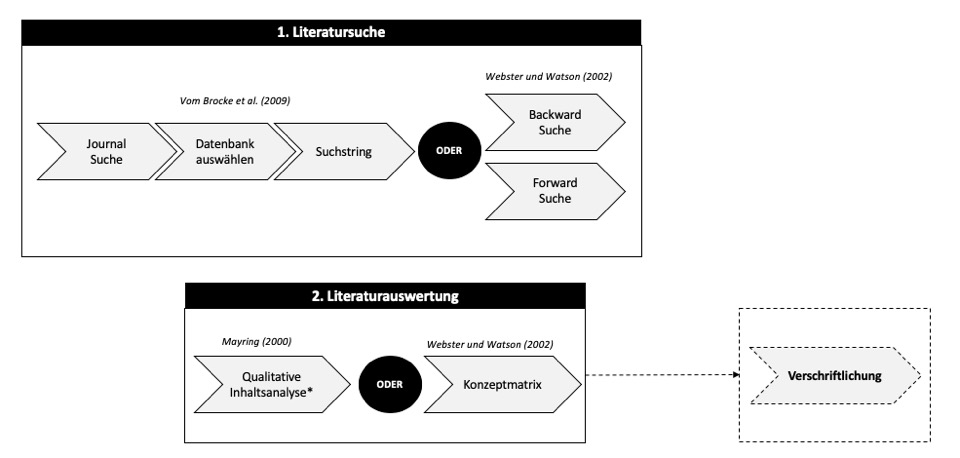In my research I have next to one Group discussion also collected the data. I have one for this quantitative survey carried out. This is used for the quick collection of data that I have in the Round tables could evaluate together with the participants. All of them are always based on a dedicated literature analysis. In this article, I’ll give you some tips on how to do this.
Reading tip: Recommended reading
The literature analysis summarizes existing knowledge in a meaningful way. A search in academic databases with the help of search strings describes, summarizes, evaluates, clarifies and integrates similar results and approaches (Fettke 2006). Although this does not primarily generate new knowledge, it can help to structure the existing knowledge and to build on it. The procedure includes the literature search, literature evaluation and analysis and interpretation in the context of the research question. The literature analysis consists of the following steps:
- Literature research (search, reduction and possibly clustering)
- Literature analysis (content analysis and presentation of the literature)
Tip: An example of a literature analysis with many suggested topics for a thesis can be found in my study from 2019.
Lindner, D., & Christian Leyh. (2019). Digitization of SMEs – questions, recommendations for action and implications for IT organization and IT service management. HMD – Praxis der Wirtschaftsinformatik , 4th , 21.

Overview of the procedures and authors
You will also have to provide a description of the methodology for your literature analysis. I would therefore like to give you four sources which are considered to be the “original papers” of literary analysis. You can quote these:
- Webster and Watson 2002 (is the original paper for literature analysis)
- Fettke 2006 (a good addition to business informatics)
- Vom Brocke et al. 2009 (Deepens the search for literature again)
- Mayring 2000 (Deepens the evaluation of the literature again)
A literature analysis always has two steps. You go in search of literature and evaluate it. I’ll give you a pretty extensive explanation for both steps. In short, in the first step you select the database, journals and quality criteria. Von Brocke et al. best represented. Then you can optionally start a forward or backward search (more later) and evaluate the literature according to Webster and Watson (2002) or Mayring (2000). I don’t count the last step, the writing, directly as a step, but I notice that students have problems here again and again and therefore explain this as well.
PS: You can download the template here and like to quote in your work.

Literature search
In the literature search, selected literature databases (e.g. scholar, springerlink, etc.) are searched in order to answer the central research question. Here I strictly follow vom Brocke et al. (2009). So you set journals, databases and variables such as time period (I recommend 3-5 years), focus and research method.
In the first step, search strings are specified such as
- digi * AND (workplace OR “knowledge work”) AND (mobil * OR individu * OR agile *)
- (company OR “organization”) AND (taylor * OR agil * OR digi *) AND (“transformation” OR “framework”)
These are entered into the various databases and you can see how many results have been found. For example, search string 2 currently delivers 1,169 results. Finally, all abstracts were examined and pre-sorted for consideration. Now comes the reduction .
In this case, I examined 97 articles more closely after reviewing the abstracts. The study can be found here, by the way . After a closer examination of the content, 13 primary sources remained as relevant papers for my research, which I used for the conception of my study.
This means that I took a closer look at all 97 posts and rated them according to their relevance. Enclosed is a large selection of relevant academic databases. I then used these 13 sources as part of the Clustering classified in 4 categories (workplace, agile methods, NewWork and Activity Based Working).
Reading tip: Book scientific reading
- EBSCO (ASC, BSC, EconLIT)
- ScienceDirect
- Emerald Web of Science
- ACM
- AISel
- EconBiz
- IEEE
- ProQuest
- Springer link
Excursus: what is academic?
The supervisor must have told you to use academic literature. But what is academic? Of the VHB-JOURQUAL3 is a ranking of economically relevant journals based on the judgments of the VHB members. The VHB4 should also come soon.
Over 1,100 members of the VHB have made a total of 64,113 reviews of magazines in the last few months. Of the 934 journals that were up for review, 651 journals exceeded the threshold of 25 reviews and received a rating. These are divided as follows:
- 22 outstanding and globally leading scientific journals in the field of business administration (A + = 3.4%),
- 72 leading academic business journals (A = 11.1%),
- 217 important and respected scientific business journals (B = 33.3%),
- 273 recognized academic business journals (C = 41.9%) and
- 59 scientific business journals (D = 9.1%).
Alternative: backword and forward search
In addition, there is the possibility not only to examine the results of the database but also to do a forward and backword search. I oriented myself to Webster and Watson (2002). Backward search is defined as the search for relevant literature from the cited sources of the article in question. Forward search is defined as searching for literature that cites this article. In concrete terms, that means: Look who is quoting the author and who is quoting the author.
The difference in the method is that, for example, you only search through the A + journals of business information systems and then recursively identify further papers from these.
Literature evaluation
In the analysis, all papers are sorted and best described by year or category. You start first with the content analysis and then with the presentation (writing) of the literature.
Reading tip: Literature search in 7 steps
There is more than one content analysis
Overall, I am familiar with four different elements of content analysis. These are:
- Structuring content analysis (Mayring 2000)
- Summary content analysis (Mayring 2000)
- Explicit content analysis (Mayring 2000)
- Concept matrix (Webster and Watson 2002)
The structuring content analysis identifies existing content and sorts it into categories based on a defined procedure. This type is very suitable if you have a fairly broad and complex subject.
example : Take leadership, for example. There are various debates about agile or virtual leadership. You will also find professional and disciplinary guidance. So it’s a very open discussion. You therefore divide the literature into the categories mentioned and describe the relevant content in each category. Example is the Study by Lindner et al. (2018).
The summary content analysis reduces the text material to such an extent that essential content is captured and a clear short text is created. This type is suitable if you have a fairly straightforward and linear topic or if it is a topic that is constantly being discussed in new contexts. For example, the term innovation, which in the 90s was more of a mechanical product and is now researching more digital services. Example is the Study by Lindner et al. (2017).
example : The aim is to present the debate about the research topic from the first mention of the examined context. The last few years can be briefly summarized here, e.g. computers at workplaces have been around since 1985 and we have not examined them until then. Then from around 2000 onwards there are numerous publications on this and these are summarized in the debate about the workplace IT. Now at the end of the analysis (last 2-3 years) the current opinions are presented more broadly. Example: In the IT workplace, research diverges. Some research into home office workplaces, others into flex desks and third into ergonomics in the workplace and so on.
The goal of the Explicit content analysis is to identify additional information (background information) on the research topic in order to achieve a higher level of understanding. I think this is used more in the natural sciences and I only mention it for the sake of completeness.
example : While you previously reduced the literature and limited it to the essential content, the goal now is to describe targeted content in great detail. I have never experienced this directly, but I could imagine the following: You are investigating the influence of the introduction of agile frameworks. Now you could do a very detailed analysis of, for example, two selected frameworks (Holacracy and LeSS). However, I have never seen such an analysis in economics or business informatics. The example can also be wrong, but I haven’t found anything better on Google either. If you have a study or example for me – I’m very welcome!
The concept matrix is the original method of Webster and Watson (2002). The two authors recommend using concepts to explain a research area. Based on the concepts of a subject area, it is checked which work pursues which concepts.
example : You want to investigate the introduction of agility and organize the literature according to research methodology. For example, you can find Case studies and expert interviews and find that there are hardly any quantitative surveys. You can also structure the literature according to the theory used. For example, look which change model an author used when introducing agility (Kotter, Rogers, …).
Presentation of the literature
Regardless of which of the four types of content analysis you choose: You have to present the selected literature, i.e. write it down. After the reduction, you have read a number of sources in full and evaluated them in the form of your chosen type of content analysis.
Now you represent source by source. The important thing is that there is no continuous text that mixes up the sources. One source after another comes. For each source answer the following questions:
- What was the author’s goal / context?
- How did the author research?
- What are the most important results in terms of my research question?
To make this clearer for you, I’ll show you a small example based on three sources on the subject of “efficiency of agile teams”.
example : O’Connor and Kelly (2012) interviewed the agile teams of 300 SMEs in the food sector in Ireland. The most important results are that, according to the SME managers surveyed, agile teams show increased employee and customer satisfaction and work speed. In 2017, Srivastava and Jain interviewed 75 Scrum Masters from India online with the same focus. The most important results are that agile teams bring higher project successes and customer satisfaction with them. The study by Lindner and Leyh (2019) provides a further perspective. In a group discussion with 12 SME decision-makers from Germany, the authors conclude that complex projects such as process digitization require greater autonomy in the execution of work and exploratory procedures, which is given by agile methods and leads to greater success.
You will notice that I have always named the authors and the research goal. Then I presented the methodology (e.g. interviews with 300 agile teams from SMEs in Ireland) as well as the most important results for the research question. You pack source to source according to this scheme.
Tip: don’t forget yours Cleanly limit methodology.
Tip: “Help! I can’t find any literature!”
I often receive emails asking me the following: I am writing about topic X and cannot find any literature . Do you have any tips? In 99% of the cases I also send literature back. However, this is not to your advantage. The reason for this is that you have to state in your thesis: Why did you use this literature. An answer like: If Mr. Lindner sent me or came by chance at Google, your supervisor will probably not be very happy.
For this reason I would like to help you how to find literature. For example, a student wrote to me who was investigating Scrum in production. So build yourself a search string that contains all the relevant words as well as synonyms: Scrum AND (Manufacturing OR Production OR Industry) and search Google Scholar first. Then also with the other databases, which I have listed above. With this search string I found some papers on Scrum in production on the first page.
Reading tip: I can’t find any literature!
“But I still can’t find anything!”
You followed my steps and still can’t find anything? Then it could be due to different points. You should rethink your topic and possibly change something together with the supervisor.
- Your topic is too new and there is no literature yet
- Your topic is not relevant in the academy, it is purely a practical topic
- You write for a company and the topic is company-specific
- Your topic will be explored in a different context
Reading tip: Search literature for specific contexts
For almost any reason, you have no choice but to turn the subject or pursue the Grounded Theory below. However, you should first try to turn your topic around by thinking outside the box. Perhaps your topic will be explored from a different perspective. For example, I would change the topic of the student (Scrum in production) by examining the influence of digitization on agility in production. There are already numerous sources and the Scrum point of view can then be derived from the data. In this way, research starts with the current discussion and the original focus can still be retained.
Reading tip: Go through the topic without literature
Alternative: “Grounded Theory”
If you still want to go through with the topic because your practice partner pays for it or you simply love the topic, then of course you can. Simply generate information yourself by starting with interviews or collecting case studies yourself. Thus, you are not building on a literature analysis, but on empirical data. So you start out on the green field without literature. I have already supervised such a master’s thesis. It’s a lot of work, so think twice about whether you want to go through with it. If you want to know more, I have written an extra article about it.
Reading tip: Grounded Theory
Conclusion: Tips on the literature analysis method
The method is very suitable for almost any research and focuses on structuring the current state of knowledge. In this way, a researcher can show that he is working on the current state of knowledge. The evaluation takes a long time, but is an important cornerstone of any research. My tips should give an initial orientation to the methodology. Definitely look too in my other book tips!
[student] Verwendete Quellen anzeigen
Mayring, P. (2000). Qualitative content analysis. In Forum Qualitative Social Research 1 (p. 10).
O’Connor, C., & Kelly, S. (2017). Facilitating knowledge management through filtered big data: SME competitiveness in an agri-food sector. Journal of Knowledge Management , 21 (1), 156-179. https://doi.org/10.1108/JKM-08-2016-0357
Srivastava, P., & Jain, S. (2017). A leadership framework for distributed self-organized scrum teams. Team Performance Management: An International Journal , 23 (5/6), 293-314. https://doi.org/10.1108/TPM-06-2016-0033
Lindner, D., & Leyh, C. (2018). Organizations in Transformation: Agility as Consequence or Prerequisite of Digitization? BT – Business Information Systems. In W. Abramowicz & A. Paschke (Eds.) (Pp. 86-101). Cham: Springer International Publishing.
Brocke, J. vom, Simons, A., Niehabes, B., & Riemer, K. (2009). Reconstruction the giant: on the importance of regour in documenting the literature search process. In 7th European Conference on Information Systems (ECIS) (p. 14).
Webster, J., & Watson, RT (2002). Analyzing the past to prepare for the future: Writing a literature review Reproduced with permission of the copyright owner. Further reproduction prohibited without permission. MIS Quarterly , 26th (2), XIII-XXIII.



